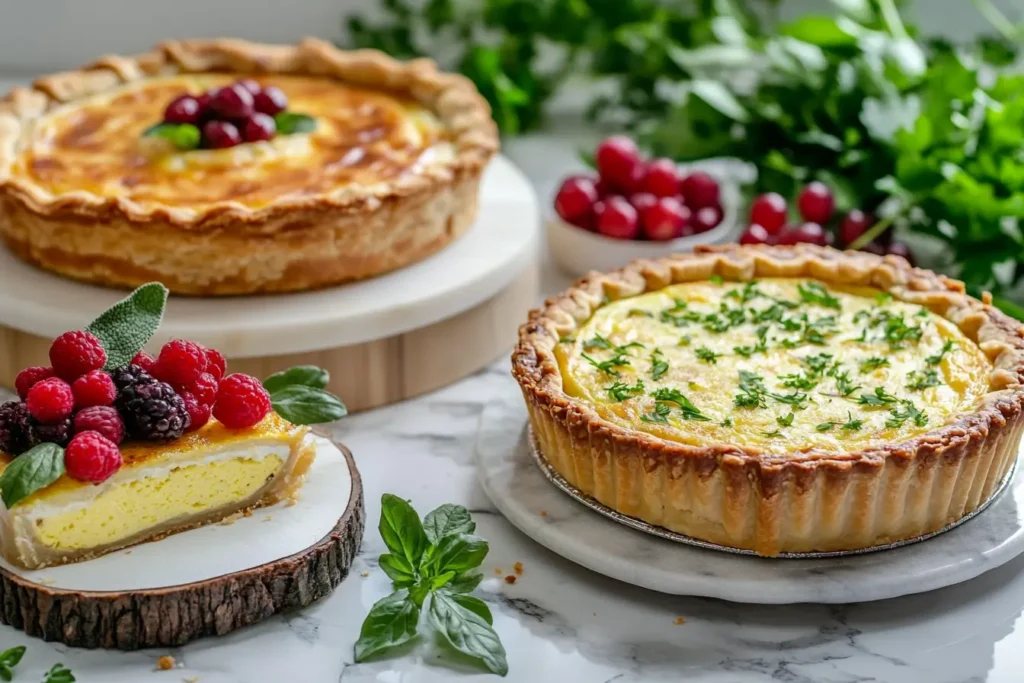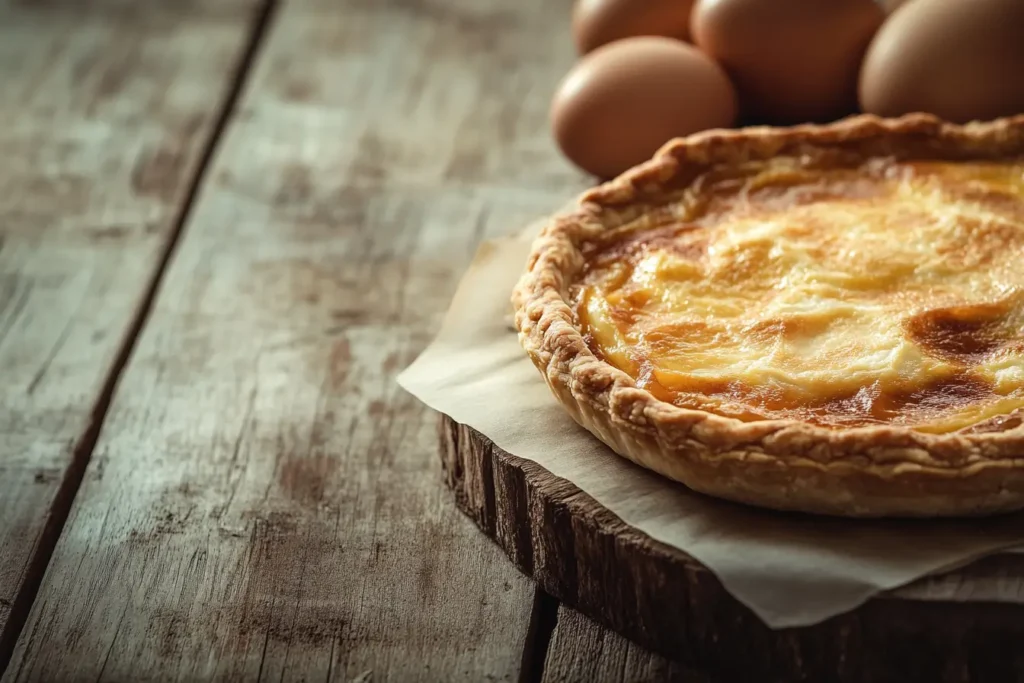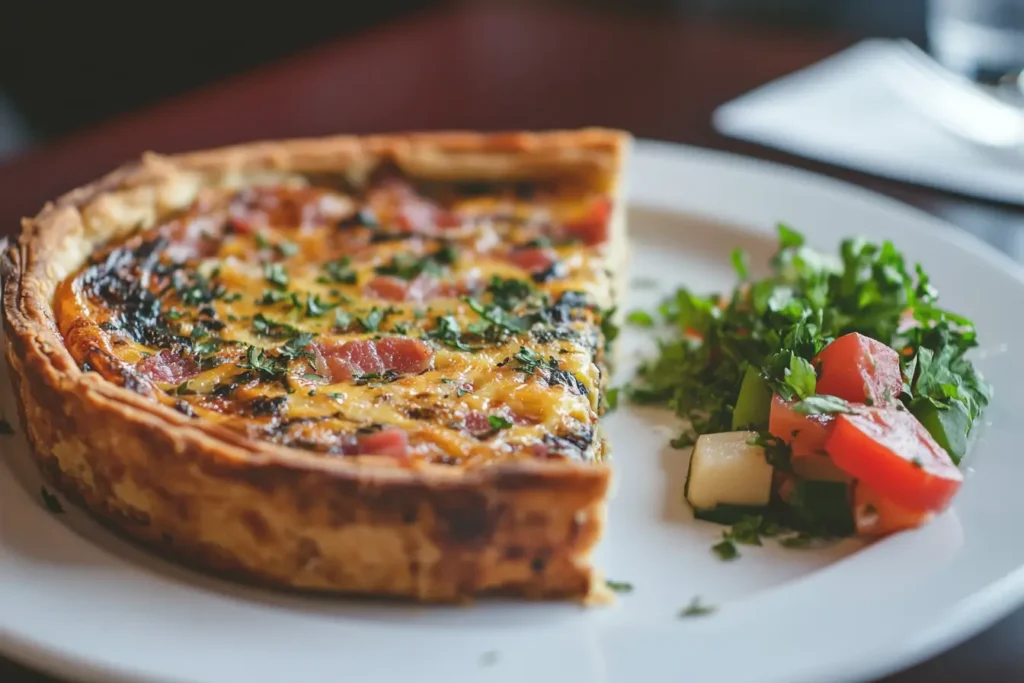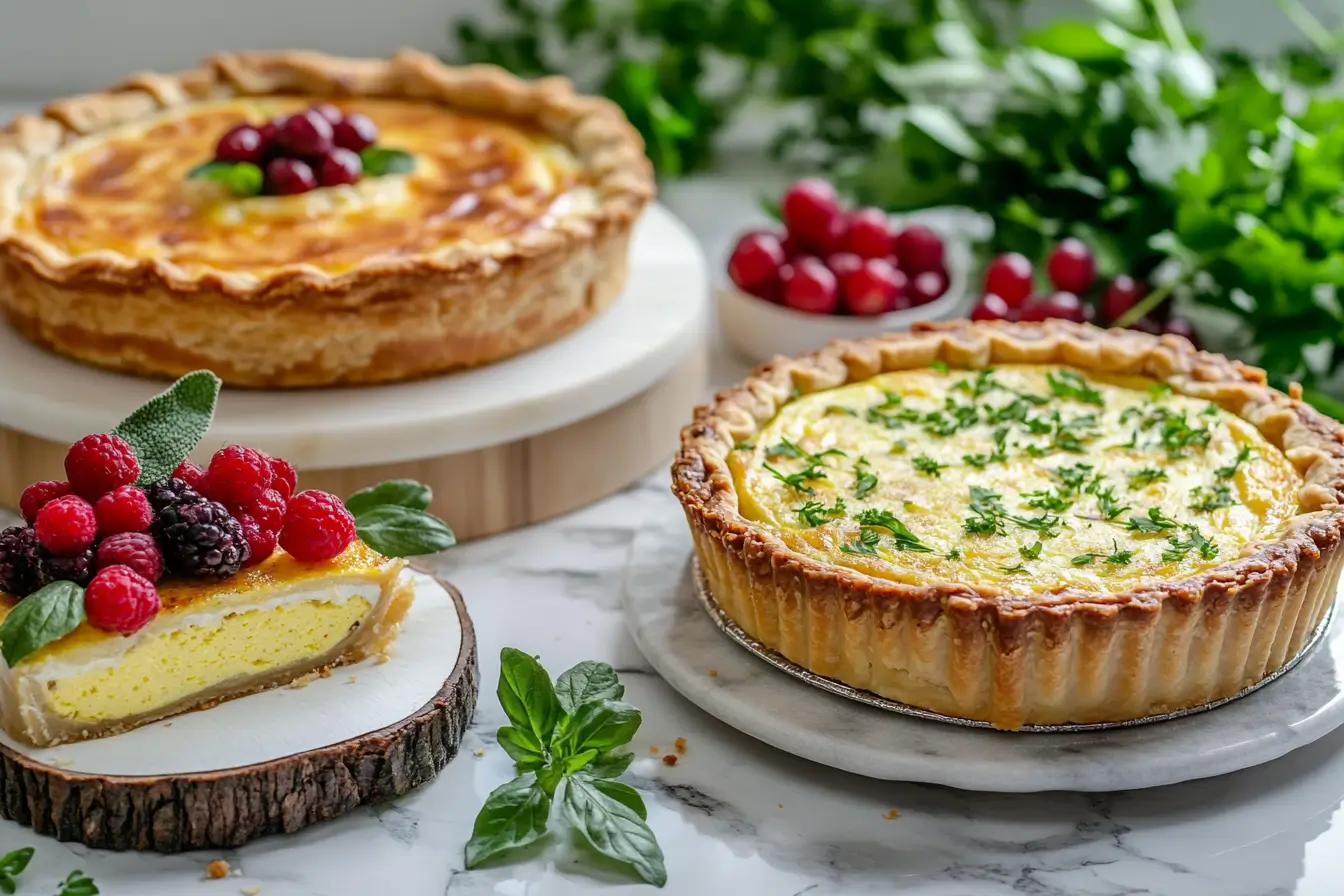
When it comes to baked dishes featuring eggs as a star ingredient, egg pie and quiche often come to mind. They may look similar at first glance, but they’re like cousins with distinct personalities. One is sweet and humble, while the other is savory and elegant. Let’s dive in and uncover what sets them apart!
Introduction to Egg Pie and Quiche
Egg pie and quiche are both versatile and delicious, but understanding their differences can help you appreciate their unique qualities. Whether you’re baking for a family gathering or just want to impress at a potluck, choosing the right dish matters. So, what’s the story behind these two egg-centric wonders?
Overview of Egg Pie
Egg pie is a sweet and creamy treat that’s particularly popular in Filipino cuisine. Imagine a custard-like filling wrapped in a buttery crust—simple yet satisfying. It’s often enjoyed as a dessert or snack, making it a favorite for people with a sweet tooth.
Overview of Quiche
Quiche, on the other hand, hails from France and takes on a savory profile. It’s a custard-based dish loaded with rich ingredients like cheese, vegetables, meats, or seafood, all nestled in a flaky crust. Perfect for breakfast, brunch, or even dinner, quiche is as fancy as it is versatile.
Key Ingredients in Egg Pie and Quiche
Ingredients are the building blocks of any recipe. While both egg pie and quiche revolve around eggs, what you mix with them creates entirely different flavors.
Common Ingredients in Egg Pie

Egg pie is known for its simplicity, and its ingredient list reflects this. Typically, it includes eggs, milk (or evaporated milk for added creaminess), sugar, and occasionally vanilla for a hint of aroma. Additionally, the crust is made from a basic mix of flour, butter, and a pinch of salt, creating a buttery and flaky base. As a result, these ingredients come together to form a silky, sweet filling encased in a perfectly golden-brown crust. Furthermore, this minimalistic approach allows the natural flavors to shine, making egg pie a universally loved dessert.
Common Ingredients in Quiche
Quiche ingredients are more adventurous. Besides eggs and milk or cream, quiche invites you to add grated cheese, sautéed onions, spinach, mushrooms—you name it! Its crust shares similarities with egg pie, but its filling is more about bold, savory layers.
Differences in Crust and Filling
Here’s where the big divergence happens:
- Egg Pie leans toward a sweeter crust that complements its dessert-like filling.
- Quiche demands a neutral crust to balance its savory ingredients.
Origin and Cultural Significance
To truly appreciate these dishes, it’s essential to take a closer look at their history and cultural roots. Both egg pie and quiche tell a unique story, reflecting the flavors and traditions of their origins.
History of Egg Pie
Egg pie’s roots are deeply tied to Filipino culture. It evolved as a local adaptation of custard pies, using ingredients readily available in the Philippines, such as milk, sugar, and eggs. Moreover, it became a nostalgic favorite, often sold in neighborhood bakeries or made at home for special celebrations. In addition, its sweet, creamy filling and flaky crust resonate deeply with family gatherings and holiday traditions, making it a beloved dessert across generations.
History of Quiche

Quiche, on the other hand, boasts an impressive lineage, originating in the Lorraine region of France. The classic quiche Lorraine—featuring cheese—showcases the dish’s rustic yet refined beginnings. Furthermore, as French cuisine gained global recognition, quiche adapted to include diverse ingredients, such as spinach, mushrooms, or seafood, depending on local preferences. Over time, its versatility and rich flavor profile transformed it into an international sensation, appearing on brunch menus and dinner tables around the world.
Transitioning from one culture to the next, we see how both egg pie and quiche have become more than just dishes—they are culinary reflections of history, creativity, and tradition.
How Regional Variations Influence Recipes
Egg pie recipes may incorporate local flavors like pandan or ube in the Philippines, while quiche takes on endless variations depending on the chef’s mood. Mediterranean-style quiches might include feta and olives, while American versions often spotlight cheddar and ham.
Preparation and Cooking Techniques
Cooking egg pie or quiche is an art. While both require similar techniques, a few key differences set them apart.
How to Make an Egg Pie
- Prepare the Crust: Roll out a dough made from flour, butter, and water. Press it into a pie dish and chill.
- Mix the Filling: Whisk eggs, sugar, milk, and vanilla together until smooth.
- Assemble: Pour the filling into the crust.
- Bake: Pop it in the oven until the filling sets, and the crust turns golden.
How to Make a Quiche
- Prepare the Crust: Similar to egg pie, but you might blind-bake it first to avoid sogginess.
- Prepare the Filling: Sauté your chosen ingredients (like onions, spinach,), then mix with eggs, cream, and cheese.
- Assemble: Combine the filling and crust.
- Bake: Bake until the custard is firm and the top is lightly browned.
Tips for Perfect Baking Results
- For egg pie, avoid overbaking to keep the custard silky.
- For quiche, pre-cook ingredients like mushrooms to reduce moisture.
“Baking is like a dance—timing and precision make all the difference.” 🥧
Nutritional Comparison: Egg Pie vs. Quiche
Let’s get into the nitty-gritty of how these dishes stack up nutritionally.
Caloric Content and Ingredients’ Impact
Egg pie, being sweet, is higher in sugar, making it calorie-dense. Quiche varies based on its filling—add a ton of cheese, and you’ve got yourself a rich, indulgent meal.
Healthier Substitutions and Alternatives
- For egg pie, swap sugar with a natural sweetener like honey or stevia.
- For quiche, use low-fat cheese or load it up with veggies for a lighter option.
Common Problems When Making Egg Pie or Quiche
Mistakes happen in the kitchen, but don’t worry—we’ve got solutions!
Preventing a Soggy Crust
- For both dishes, chilling the crust before baking helps.
- Blind-baking (baking the crust alone before adding the filling) is a lifesaver for quiche.
Avoiding Overcooked or Undercooked Fillings
- Use a knife or toothpick to check if the custard is set. It should come out clean.
- Avoid high oven temperatures—low and slow is the way to go.
Solutions for Cracking or Shrinking Crusts
- Don’t overwork your dough; too much handling toughens it.
- Allow the dough to rest before rolling it out.
Preparation and Cooking Techniques: Secrets to Success
Both egg pie and quiche require a delicate balance of ingredients and techniques. The filling should be silky and flavorful, and the crust—well, it’s all about getting that golden, flaky perfection. Let’s dive into how to make each dish step-by-step.
How to Make an Egg Pie
Making an egg pie is straightforward, but the magic lies in its simplicity. Here’s a detailed guide:
- Prepare the Crust:
Start with a basic shortcrust pastry. Mix flour, butter, and a pinch of salt until crumbly, then add cold water to form a dough. Chill it for 30 minutes to ensure it’s easy to roll and bake evenly. - Roll and Press:
Roll the dough out into a circle slightly larger than your pie pan. Gently press it into the pan and trim off the edges. - Prepare the Filling:
Whisk together eggs, sugar, evaporated milk, and a splash of vanilla extract until smooth. This mixture forms the heart of your egg pie. - Assemble and Bake:
Pour the filling into the crust and bake at 350°F (175°C) for 40–50 minutes. Keep an eye on it—the top should be lightly golden, and the filling should wobble slightly in the center. - Cool Before Serving:
Egg pie sets as it cools, so patience is key. Let it cool to room temperature before slicing.
Pro Tip: “For an extra glossy top, brush the pie’s surface with an egg wash before baking.”
How to Make a Quiche
Making a quiche takes a bit more effort, but the payoff is worth it. It’s all about layering flavors while ensuring the custard stays creamy and rich.
- Blind-Bake the Crust:
Roll out the dough and fit it into your pie dish. Prick the bottom with a fork, line it with parchment paper, and fill it with baking beans. Bake for 10–15 minutes at 375°F (190°C) to prevent sogginess. - Prepare the Filling:
Sauté your chosen ingredients (like onions, spinach,) to remove excess moisture. Whisk together eggs, cream, milk, and seasonings like salt, pepper, and a pinch of nutmeg. - Layer and Pour:
Spread the sautéed ingredients and shredded cheese evenly across the crust. Pour the custard mixture over the top, making sure everything is submerged. - Bake to Perfection:
Bake at 375°F (190°C) for 35–45 minutes, or until the custard is set but slightly jiggly in the center. Let it cool slightly before slicing.
Chef’s Insight: “Cheese is your quiche’s best friend. Go bold with Gruyère, sharp with cheddar, or creamy with goat cheese for a flavor boost.” 🧀
Mastering the Art of the Perfect Crust
Ah, the crust—a defining feature of both egg pie and quiche. Here’s how to achieve a crust so good, it’s worth eating on its own.
Common Crust Pitfalls
- Soggy Bottoms: Nobody likes a damp crust. To avoid this, ensure your dough is well-chilled and blind-bake for quiche.
- Shrinking Crust: Overworking the dough can cause shrinkage. Handle it gently and allow it to rest before rolling.
- Crumbly or Tough Texture: Balance is key. Too much flour makes it tough, while too much butter makes it crumbly.
Perfect Crust Tips
- Use Cold Ingredients: Cold butter and ice water are essential for creating flaky layers.
- Chill Before Baking: After pressing the dough into the pan, chill it again to prevent melting during baking.
- Egg Wash for Shine: A light brush of beaten egg on the crust edges creates a beautiful golden hue.
Troubleshooting Common Baking Issues
Even seasoned bakers run into hiccups. Here’s how to fix the most common problems when baking egg pie or quiche.
Preventing Overcooked or Undercooked Fillings
The trick is all in the temperature:
- Bake low and slow. A temperature of 350°F (175°C) is your sweet spot.
- Check doneness by inserting a toothpick—it should come out clean but moist.
Avoiding a Watery Filling
Nobody wants a soggy center! For egg pie, ensure your milk-to-egg ratio is correct. For quiche, pre-cook watery ingredients like mushrooms or zucchini.
Fixing Cracked Custard
Cracking happens when the filling overcooks or cools too quickly. To avoid this:
- Remove the pie or quiche just before it fully sets—the residual heat will finish the job.
- Cool it slowly in the oven with the door slightly ajar.
“Think of your custard as a delicate dance partner—handle it with care, and it’ll perform beautifully.” 🥧
Getting Creative with Flavors and Fillings
Once you’ve mastered the basics, it’s time to have some fun in the kitchen! Here are some creative spins on egg pie and quiche that will impress everyone at the table.
Egg Pie with a Twist
- Coconut Milk Custard: Replace regular milk with coconut milk for a tropical vibe.
- Lemon-Infused Pie: Add a splash of lemon juice and zest to the custard for a refreshing tang.
- Spiced Egg Pie: Experiment with cinnamon or nutmeg for a warm, comforting flavor.
Quiche for Adventurous Palates
- Mediterranean Quiche: Load it up with sun-dried tomatoes, olives, and feta cheese.
- Breakfast Quiche: Add sausage, hash browns, and cheddar for a hearty morning meal.
- Sweet and Savory: Try figs and prosciutto with a hint of honey drizzled over the top.
Inspiration: “Cooking is like storytelling—every ingredient adds a new chapter to the tale.”
Egg Pie or Quiche: Making the Final Choice
Choosing between egg pie and quiche often depends on your taste preferences and the event you’re planning for. Let’s break it down:
Egg Pie: Sweet Simplicity
Egg pie is perfect for:
- Casual Gatherings: Its simplicity makes it a hit at family get-togethers.
- Comfort Food Moments: When you crave something sweet and nostalgic, egg pie is your best friend.
- Dessert Tables: Egg pie adds a sweet, creamy touch to any dessert spread.
Quiche: Savory Sophistication
Quiche is ideal for:
- Brunches: Its rich, savory profile fits perfectly on a morning or midday table.
- Special Occasions: Impress guests with a gourmet dish that’s easy to make.
- Versatility: From vegetarian options to meaty delights, quiche can be tailored to suit everyone.
Breakfast Pie Recipes
In the section discussing quiche as a breakfast option, link to the “Breakfast Pie Recipes, Tips, and Ideas” post. This can provide readers with creative inspirations for quiche and other breakfast-friendly pies.
Can You Have Pies for Breakfast?
When addressing the versatility of quiche and egg pie, link to the “Can You Have Pies for Breakfast?” article. It’s a natural fit for discussing breakfast-friendly pies and their adaptability.
Egg-Based Pies
To enrich the content on egg pie, link to the “Egg-Based Pies” post. This can expand on the variety of sweet and savory pies that use eggs as a core ingredient.
Conclusion: Which Pie Will You Try First?
Now that we’ve explored the distinct flavors, preparation techniques, and occasions for egg pie and quiche, it’s your turn to decide! Whether you’re craving the sweet simplicity of an egg pie or the rich versatility of a quiche, both dishes have a place in your kitchen. Try them both, experiment with fillings, and most importantly—enjoy the process. 😊
By weaving in relevant internal links, we’ve not only enhanced the article’s SEO but also provided a seamless journey for readers to explore related content. Ready to bake? 🥧

